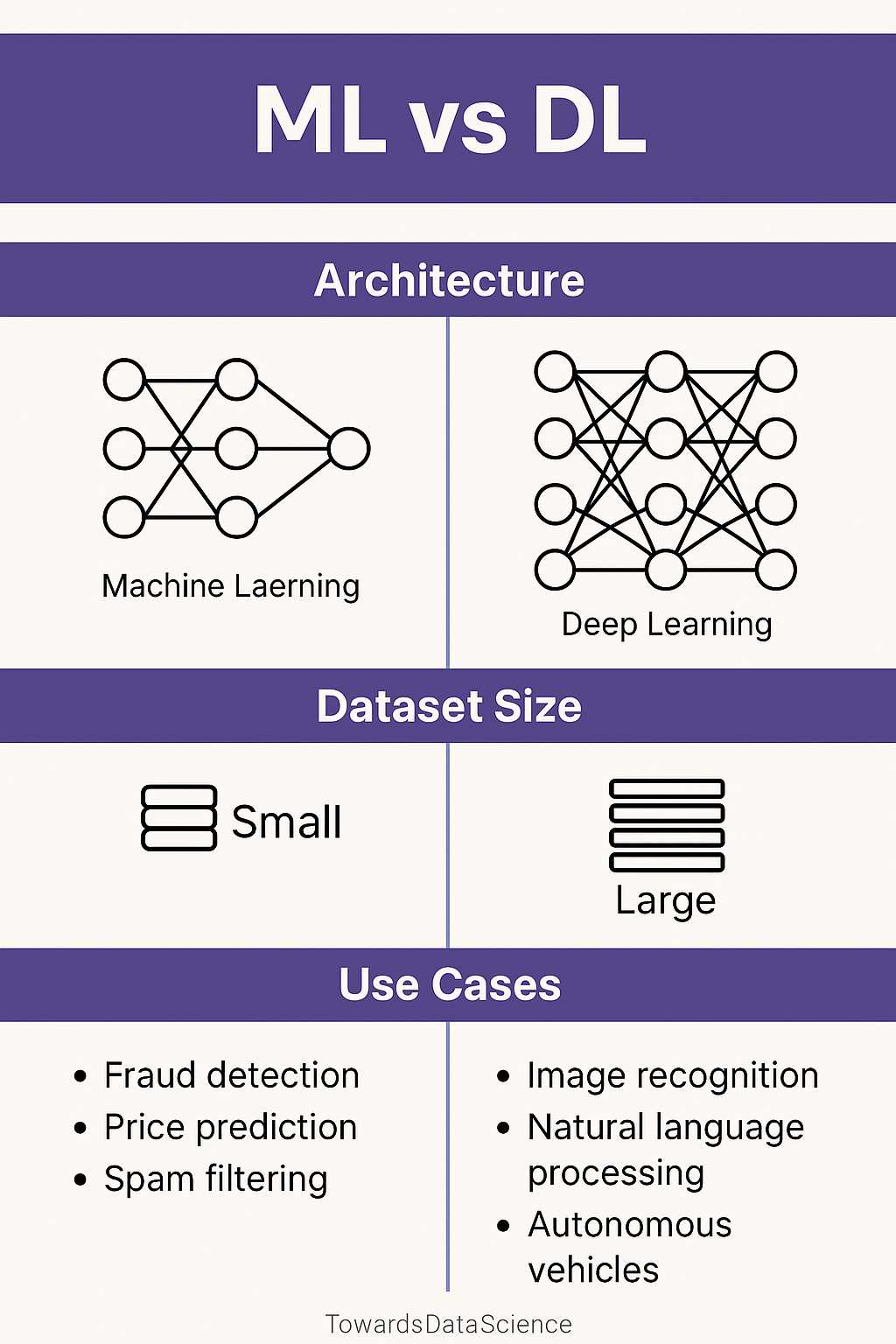Learn the key differences between machine learning and deep learning. Understand how they work, real-world applications, and which one to use when.
📌 Table of Contents
- What is Machine Learning?
- What is Deep Learning?
- Key Differences Between ML and DL
- Real-World Examples
- When to Use ML vs DL
- Challenges and Limitations
- Final Thoughts
🤖 What is Machine Learning (ML)?
Machine Learning is a subset of artificial intelligence that enables computers to learn from data without being explicitly programmed. The goal is to allow systems to improve performance over time based on experience.
Common ML Algorithms:
- Linear Regression
- Decision Trees
- Support Vector Machines (SVM)
- K-Means Clustering
- Random Forest
Example:
Predicting house prices based on features like size, location, and number of rooms.
🧠 What is Deep Learning (DL)?
Deep Learning is a more complex subset of machine learning based on artificial neural networks. These networks try to mimic the human brain’s structure and can learn patterns in large datasets.
Common DL Architectures:
- Convolutional Neural Networks (CNNs) for images
- Recurrent Neural Networks (RNNs) for sequences
- Transformers for natural language processing (e.g., ChatGPT)
Example:
Image recognition (e.g., detecting cats in photos) or language translation.
🆚 Key Differences Between Machine Learning and Deep Learning
| Feature | Machine Learning | Deep Learning |
|---|---|---|
| Data Dependency | Works with small to medium datasets | Requires large datasets |
| Hardware Needs | Can run on standard CPU | Needs powerful GPU/TPU |
| Feature Engineering | Manual feature extraction | Automatically extracts features |
| Execution Time | Faster to train | Slower due to complexity |
| Interpretability | Easier to understand results | Black-box models, harder to interpret |
🔍 In Short:
Machine Learning is simple and interpretable. Deep Learning is powerful and automatic but needs more resources.
🌍 Real-World Examples
✅ Machine Learning in Action:
- Email spam detection
- Customer churn prediction
- Loan approval systems
✅ Deep Learning in Action:
- Self-driving cars
- Voice assistants like Alexa or Siri
- Medical imaging diagnosis (e.g., identifying tumors)
🤔 When to Use ML vs DL
| Scenario | Use ML if… | Use DL if… |
|---|---|---|
| Dataset size | You have < 10,000 samples | You have millions of records |
| Interpretability | You need to explain decisions | You don’t need transparency |
| Resources | You have limited hardware | You have GPU/TPU access |
| Timeline | You need fast deployment | You have time to train models |
⚠️ Challenges and Limitations
Machine Learning:
- Requires significant feature engineering
- May underperform on unstructured data (images, audio)
Deep Learning:
- Long training time
- Prone to overfitting
- Expensive to train and test
🧠 Final Thoughts
Machine Learning and Deep Learning aren’t enemies—they’re teammates. ML is great for structured data and quick wins. DL excels in solving complex problems like language, vision, and speech.
Choose the right tool based on data availability, goal clarity, and hardware access.
